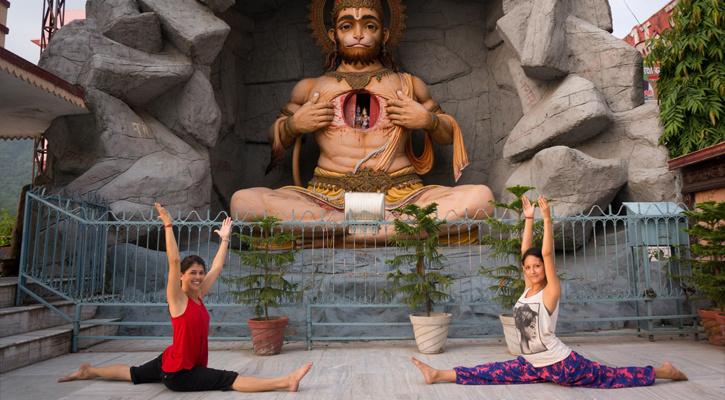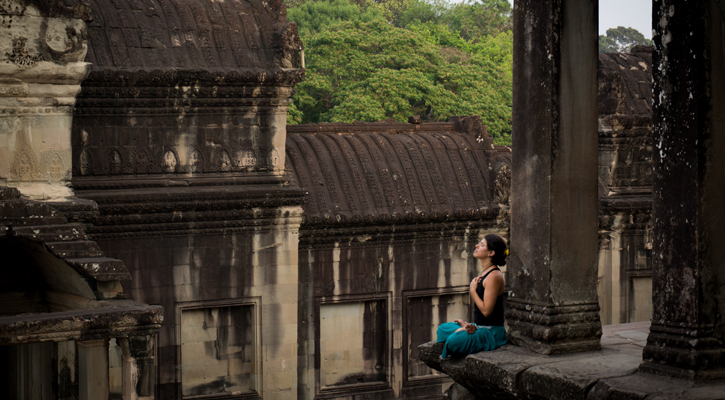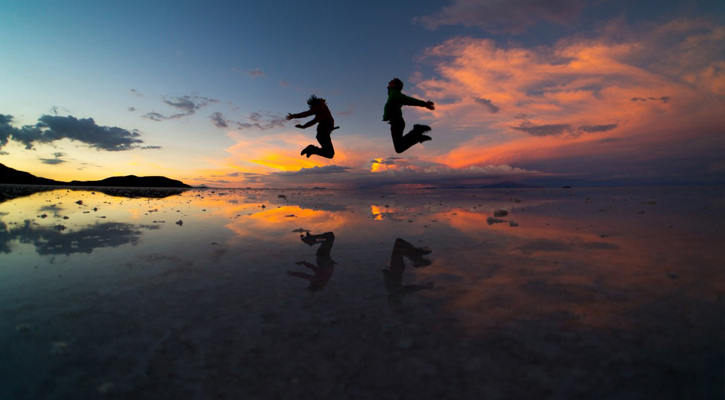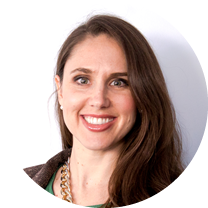Welcome back to the Sanky family, Julie!
 Julie and a friend perform Hanumanasana in front of a statue of the yoga posture's namesake in Rishikesh, India, along the banks of the Ganga River.
Julie and a friend perform Hanumanasana in front of a statue of the yoga posture's namesake in Rishikesh, India, along the banks of the Ganga River.
After six years at Sanky, Julie Ziff Sint left Sanky for a truly epic travel and study sabbatical. She and her husband bought one-way plane tickets out of New York and set off for faraway lands—traveling everywhere from Antarctica to Kathmandu!
After her return to the U.S., she spent a year as the Associate Development Director for a New York City-based nonprofit. And lucky for us, Julie recently decided to return to Sanky as an Account Director. :-)
A self-described “do-gooder by nature,” she has over 15 years of experience in the nonprofit sector, with a background that spans digital fundraising, integrated direct marketing, website strategy, bridge and major gifts fundraising, development operations, special events, and media relations.
In addition to being a fabulous fundraising strategist and intrepid world traveler, Julie is also a yoga teacher, bodyworker, and circus arts performer. She’s one busy lady, that’s for sure!
We’re so happy to have Julie back in the Sanky family and are excited to share a quick Q & A with her, as well as some of her incredible (slash envy-inducing!) travel photos.
Q & A
What were three top moments or highlights on your epic worldwide adventure?
For sheer natural beauty, the Salar de Uyuni offered literally the most beautiful hour of my life, Antarctica is indescribable, and the Himalayas are humbling. There are the teachings—I participated in a teaching with His Holiness the Dalai Lama, spent about two months studying Thai Bodywork with true masters, and spent a few months in India studying yoga with inspirational teachers I can only hope to emulate one day. Of living culture, there is something breathtaking about seeing the saffron and crimson of Buddhist monks’ robes against the colors of the temples in Laos and Thailand, the ruins of Angkor Wat, or the stupa-studded landscape of Bagan. And food, of course! There’s the naan, fresh from a street-side tandoori oven in India and Nepal, khao soi in northern Thailand (I have an ongoing search for the best in NYC, which everyone is invited to join), really any street food in Bangkok, and luscious cherimoya or tangy granadilla in the foothills of the Andes.
 A moment of solitude escaping the crowds, perched on a ledge of a ruin in the Angkor Wat area of Cambodia.
A moment of solitude escaping the crowds, perched on a ledge of a ruin in the Angkor Wat area of Cambodia.
Did you meet anyone inspiring on your trip (perhaps people working in the nonprofit world)?
From the nonprofit world, there are two organizations that stood out. One is the Mahabodhi Center in Ladakh. It is a Buddhist temple and retreat center and has residential educational programs for children and other high-need populations in a very special and unique environment. They invite donors to sponsor students, which is a rewarding connection on both ends. The other is Children’s Future, a nonprofit school and center in Battambang, Cambodia. Cambodia has a unique recent political history, which has led to issues with human trafficking and the child sex trade, as well as proper access to educational opportunities and medical support. As an inspiring antidote, Children’s Future is a safe oasis for many children. It focuses on education, but also provides a wide range of other support (housing, food, medical, self-esteem) for its kids.
What is it about the nonprofit sector that you love?
My entire career has been devoted to the nonprofit sector. It sounds silly, but I can’t imagine what it would be like to work for an organization where the end game was to make money. In my mind, the end game of fundraising is to make money to support something—research, advocacy, better laws, better protection, social services, education, preservation, etc.
How has the nonprofit world changed since you started working in it?
Flash back to 1998 when I interned in the education department at the Wildlife Conservation Society’s Central Park Zoo, and a year later to my first fundraising role with the National Audubon Society. Obviously things have changed dramatically—my career as it is now, “digital fundraising strategy,” didn’t exist. 56K modems were pretty exciting (as were AOL chat rooms), “google” meant a really big number, and a “facebook” was a paper booklet from freshman orientation. But all joking aside, I’m more interested in what’s stayed the same. Donor acquisition is all about finding people who are interested in your work and starting a conversation. Donor retention relies on stewardship, which is just another word for building relationships. Now we just have more channels and more tools. The multi-channel approach—events, volunteerism, phone, mail, email, web, social, search, video, petitions, etc.—just allows us to find more people who are interested in the mission and build a more dynamic relationship with constituents.
What’s special about Sanky, and what are you most excited to dive into now that you’re back?
Through my career explorations, I’ve only recently come to realize just how rare and special it is that the staff at Sanky is deeply passionate about the wide range of causes our clients represent. Our goal is not for “Sanky” to succeed, but rather our success as an agency comes when our nonprofit partners reach success. It’s a tremendous team—really a tremendous family—that has come together with that mentality.
 Sunset in Bolivia's Salar de Uyuni. If you're lucky enough to catch it with an inch of water, the salt flat becomes an enormous mirror—approx. 10 square kilometers!
Sunset in Bolivia's Salar de Uyuni. If you're lucky enough to catch it with an inch of water, the salt flat becomes an enormous mirror—approx. 10 square kilometers!
Like what you read? Check out this related post:
